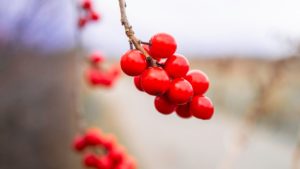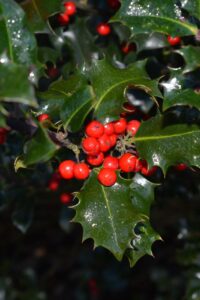A garden painted in shades of red evokes passion, energy, and elegance. If you’re seeking to infuse your Cleveland, Ohio landscape with the fiery charm of red blooms all year long, look no further. We’ve curated a collection of striking red plants that will grace your garden with new bursts of color each month.
January – Winterberry (Ilex verticillata)

Winterberry is a striking shrub that defies the winter gloom with its vibrant red berries. Adorning bare branches, it’s a treat for both eyes and birds during chilly months.
Sunlight: Winterberry thrives in full sun to partial shade.
Soil: Plant in moist, acidic soil that is well-draining.
Watering: Regular watering is crucial to keep the soil consistently moist.
Pruning: Prune to shape in late winter or early spring.
February – Redtwig Dogwood (Cornus sericea)
In the heart of winter, Redtwig Dogwood shines with its fiery red stems. Its vibrant color is a testament to the beauty that exists even in the coldest months.
Sunlight: Plant in full sun to partial shade.
Soil: Redtwig Dogwood thrives in moist, well-draining soil.
Watering: Keep the soil consistently moist during the growing season.
Pruning: Prune to rejuvenate stems by removing old ones in late winter.
March – Japanese Quince (Chaenomeles japonica)
March brings forth the Japanese Quince’s scarlet blossoms. These vibrant flowers signal the awakening of spring’s red palette.
Sunlight: Plant in full sun for optimal flowering.
Soil: Japanese Quince prefers well-draining soil with average fertility.
Watering: Keep the soil evenly moist during the growing season.
Pruning: Prune after flowering to shape and encourage new growth.
April – Redbud (Cercis spp.)
April sees the Redbud decked in pinkish-red blooms. Its unique blossoms add a touch of elegance to the spring landscape.
Sunlight: Plant in full sun to partial shade.
Soil: Redbuds thrive in well-draining soil that’s slightly acidic.
Watering: Keep the soil consistently moist, especially during establishment.
Pruning: Prune to remove dead or crossing branches.
May – Weigela (Weigela spp.)
June – Bee Balm (Monarda spp.)
Bee Balm bursts forth in June with its red blooms that attract pollinators like a magnet. Its vibrant color is matched only by its ecological value.
Sunlight: Plant in full sun to partial shade.
Soil: Bee Balm prefers moist, well-draining soil.
Watering: Keep the soil consistently moist, especially during hot spells.
Pruning: Prune after flowering to prevent self-seeding and promote bushy growth.
July – Daylily (Hemerocallis spp.)
July belongs to the Daylily, which flaunts its fiery red blooms. These resilient flowers are a symbol of summer’s vibrancy.
Sunlight: Plant in full sun to light shade.
Soil: Daylilies thrive in well-draining soil with good fertility.
Watering: Keep the soil consistently moist during the growing season.
Pruning: Remove spent flowers to encourage continuous blooming.
August – Cardinal Flower (Lobelia cardinalis)
August witnesses the Cardinal Flower’s intense scarlet spikes. These native blooms are a beacon for hummingbirds and a testament to the beauty of late summer.
Sunlight: Plant in partial shade to full sun.
Soil: Cardinal Flower prefers consistently moist, rich soil.
Watering: Keep the soil consistently moist, especially during hot spells.
Pruning: Remove spent flowers to encourage reblooming and prevent self-seeding.
September – Autumn Blaze Maple (Acer x freemanii ‘Jeffersred’)
The September landscape is transformed by the Autumn Blaze Maple’s scarlet foliage. Its vibrant leaves add warmth to the transitioning season.
Sunlight: Plant in full sun for best fall color.
Soil: Autumn Blaze Maple thrives in well-draining soil.
Watering: Regular watering, especially during establishment, is essential.
Pruning: Prune to shape in late winter or early spring.
October – Burning Bush (Euonymus alatus). This deciduous shrub is known for its striking red foliage in the fall, adding a vibrant splash of color to your garden. It is hardy in USDA zones 4-8, making it suitable for Cleveland’s climate. The Burning Bush is also relatively easy to care for and can thrive in various soil types with proper sunlight.
November – Winterberry (Ilex verticillata)
Winterberry (Ilex verticillata) is a deciduous holly native to North America, cherished for its striking bright red berries that illuminate the winter landscape. Unlike its evergreen relatives, winterberry sheds its leaves in autumn, leaving clusters of vibrant berries on bare branches, providing a stark and beautiful contrast against the snowy backdrop. This quality makes it a popular choice for winter gardens and naturalized areas, where its berries can attract birds and add color during the dormant season.
Growing well in wet, acidic soils, winterberry is particularly suited to boggy areas and can thrive in full sun to partial shade. It is hardy in USDA zones 3-9, making it versatile for various climates, including the cold winters of the northern United States. The plant requires both male and female plants for berry production, with one male able to pollinate several female plants. This characteristic is essential for gardeners to consider when planting to ensure a bountiful display of berries.
Historically, winterberry has been used in traditional medicine for various ailments. Native American tribes utilized the bark and berries to treat fever, digestive issues, and inflammation. However, the berries are toxic if ingested in large quantities, so they should be handled with care. Despite its medicinal uses, winterberry is primarily valued for its ornamental appeal, providing much-needed color and interest to winter landscapes and serving as a critical food source for birds during harsh winter months.
December – Holly (Ilex spp.)

Holly (Ilex spp.) is a versatile plant, ranging from small shrubs to towering trees, and is known for its glossy, often spiny leaves and bright red berries. It thrives in well-draining, slightly acidic soil and prefers full sun to partial shade. Regular watering is essential, especially during its establishment period. Hardy in USDA zones 5-9, holly is an evergreen that adds year-round interest to gardens, with its berries reaching peak vibrancy in December, providing festive color and attracting birds.
Historically, holly has held cultural significance, symbolizing protection and eternal life, especially during winter holidays like Christmas. Its leaves, berries, and bark have been employed in herbal remedies to treat conditions such as fever, digestive issues, and inflammation. However, it is important to note that holly berries can be toxic if consumed in large quantities, so they should be used with caution in medicinal practices.
When adding holly to a red-themed landscape, consider its use as hedges, foundation plantings, or accent plants. Pair it with other evergreens and red-berried plants for a cohesive look, and prune in late winter to maintain shape and health. Additionally, holly varieties offer options with variegated leaves or different berry colors, enhancing its appeal in diverse garden settings.
Sources
- Missouri Botanical Garden – Ilex spp.
- Royal Horticultural Society – Holly
- University of Florida IFAS Extension – Ilex spp.
- The Spruce – How to Grow and Care for Holly
- Better Homes & Gardens – Holly
- WebMD – Holly Uses
- Missouri Botanical Garden – Ilex spp.
- NC State Extension – American Holly
- Missouri Botanical Garden – Winterberry
- The Morton Arboretum – Winterberry
- University of Arkansas Division of Agriculture – Winterberry
- WebMD – Winterberry Uses
Send us a message on Instagram and tell us what your favorite red plant is.




